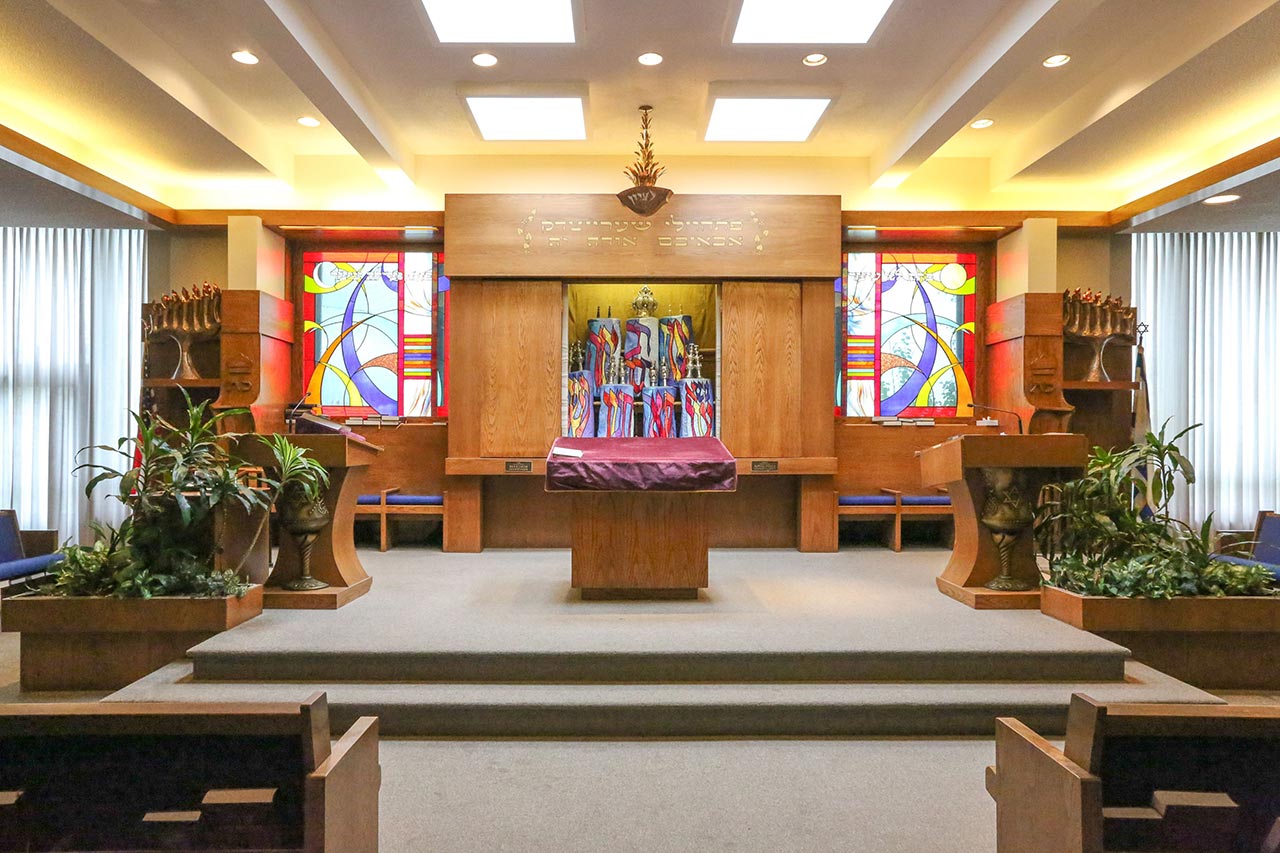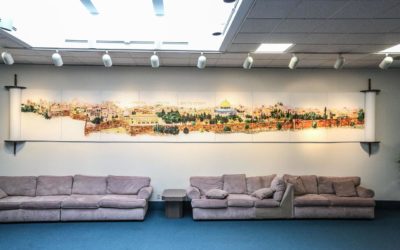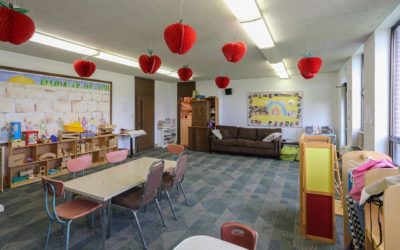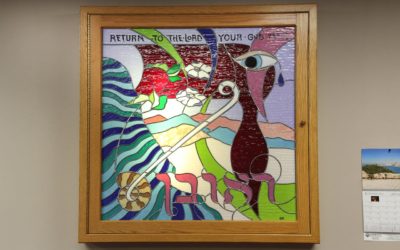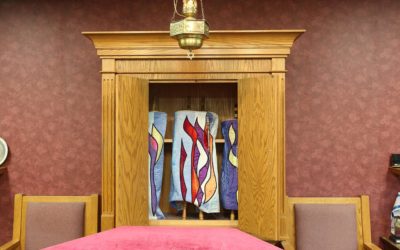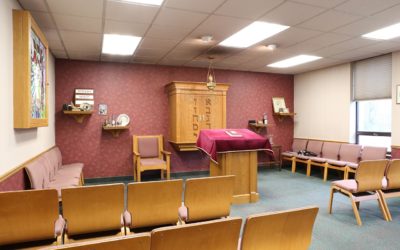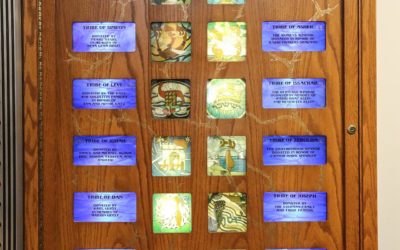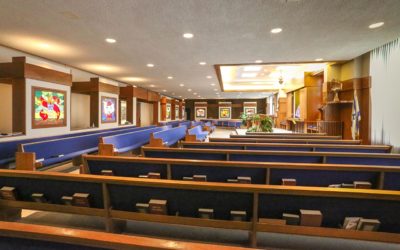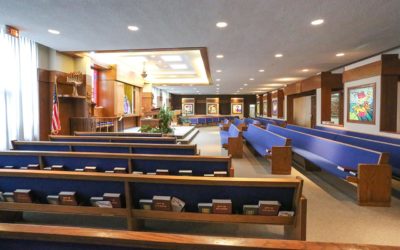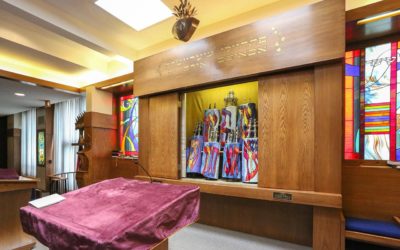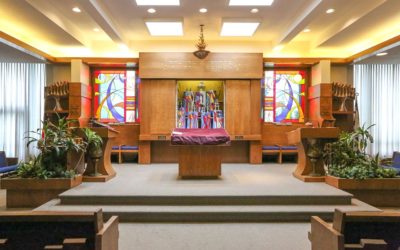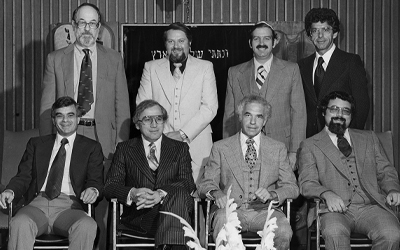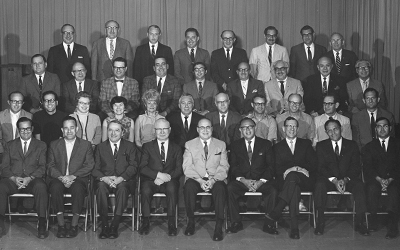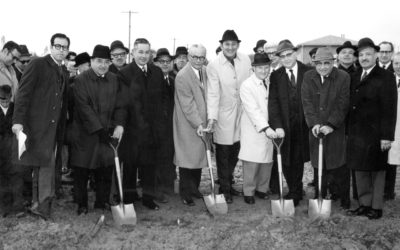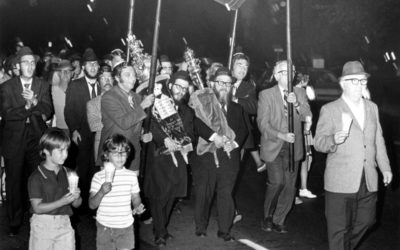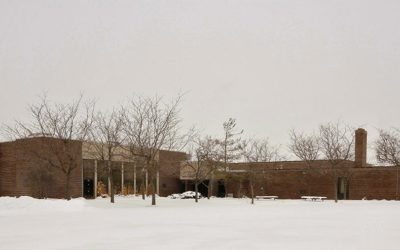Synagogues / Temple Shaarey Zedek
Overview
Two distinctive North Buffalo congregations aligned with Conservative Judaism, came together to form Temple Shaarey Zedek in the later 1960s. Breaking ground in Getzville, near Rosary Hill College (later renamed Daemen College in 1976), the newly minted congregation set about closing their existing sites. Temple Emanu-El on Tacoma was sold first, but Temple Beth David-Ner Israel at Starin remained in use until a sanctuary was added in Getzville designed by Irwin Klein. The newly combined congregation of 775 members joined other congregations based wholly in the suburbs. Led by Dr. Rabbi Isaac Klein, previously of Temple Emanu-El, in his 15th year in the rabbinate in Buffalo, he was a highly respected figure within Conservative Judaism, as a leader and a halachic authority. Beloved by his congregation and students at JTS alike, he was also a founder facilitator for Kadimah School of Buffalo, that made its home at Shaarey Zedek intermittently. Many of the movements towards greater community wide religious observance could be traced back to Rabbi Klein’s influence. In 1970, however, due to health reasons he began to scale back his workload that also included summer teaching at JTS and the University of Judaism (now the American Jewish University in combination with the formerly the separate Brandeis-Bardin Institute). In 1972, he retired from the rabbinate and continued to work on several books including The Anguish and the Ecstasy of a Jewish Chaplain (1974), and his translation of The Code of Maimonides (Mishneh Torah): Book 7, The Book of Agriculture (1979) and his posthumous Guide to Jewish Religious Practice (1979), still used as a ready reference source.
Over the next decade Temple Shaaray Zedek had a number of rabbinical leaders including Rabbi Sanford Shanblatt and Rabbi Shlomo Stern. During Rabbi Stern’s tenure the congregation celebrated groundbreaking in 1981 for a sanctuary with its dedication on December 4, 1982. By then the Religious School Director was Rabbi Shay Mintz, who ran a successful joint community High School program with students also drawn from Beth El and Temple Sinai. Educational joint ventures, either through venue rental or shared staffing, or cooperative planning was a significant thread. Early in 1970, Temple Shaarey Zedek had welcomed Kadimah kindergarten students to its building and continued to offer space to Kadimah intermittently. In the meantime the congregation’s own needs saw full utilization of the basement for youth groups and classrooms. Janet Adler, Elaine Altman, Ray Abramovitz, Judy Grossbard and Tish Schiffman served as religious school principals across this period. Separately the addition of a wing to the social hall expanded options.
In 1987, the congregation welcomed Cantor Mark Spindler. Trained at the Cantors’ Institute, at Yeshiva University, he had served both the Brothers of Israel in Trenton and Lake Hiawatha Jewish Center in New Jersey, when he accepted the role at Temple Shaarey Zedek. Twenty-five years later, on November 17, 2012 he celebrated his quarter century in the Cantorate in Temple Shaarey Zedek successor congregation: Temple Beth Tzedek. Around the same time that “Cantor Mark”, joined the team, Jerome Frank, longtime administrator was succeeded by Allan Werbow. He would provide a long period of steadiness over the next 30 plus years, including through the during the merger with Temple Beth El. In 1995, Temple Shaarey Zedek absorbed the kindergarten and Lower School while the Middle School made a home at the Jewish Community Center in Getzville. Later Leah Schneider, also a teacher at Kadimah, assumed the role of Religious School principal. Other changes within the temple included the commission of a mural, Jerusalem of Gold, designed by Irving B. Mink, which filled the hallway between the social hall and the sanctuary. Jane Jacobsen, a stained-glass artist, created twelve glass mosaic pieces on the theme of the tribes of Israel for the sanctuary. During the 1990s, when Rabbi Eliot Marrus served as the spiritual leader, and Temple Shaarey Zedek returned to a greater involvement in Christian-Jewish interfaith work as Rabbi Marrus was appointed to the presidency of the Buffalo Area Metropolitan Ministries, a group of 23 religious communities.
In the 2000s, like many other congregations facing demographic change, Temple Shaarey Zedek voted to merge with another Conservative synagogue to stabilize its membership numbers. Synagogue members celebrated their fortieth anniversary in June 2008, just a few weeks after a joint vote with Temple Beth El where congregants in each temple agreed to a merge to form Temple Beth Tzedek.
Architectural Information
Architect: Irwin Klein
Stained Glass Artist: Jane Jacobsen
Location
Articles
An emotional shalom as synagogue ends—and begins Temple Beth El holds final service as historic congregation merges
An emotional shalom as synagogue ends—and begins Temple Beth El holds final service as historic congregation merges, Buffalo News, June 10, 2008
Synagogues ready vote for May 14 on merging Shaarey Zedek, Beth El affected
Synagogues ready vote for May 14 on merging Shaarey Zedek, Beth El affected, Buffalo News, Apr 10, 2008
Members vote to merge two temples
Members vote to merge two temples, Buffalo News, May 16, 2008
Rabbi Succeeds Catholic Priest as Leader of Interfaith Ministry
Rabbi Succeeds Catholic Priest as Leader of Interfaith Ministry, Buffalo News, February 22, 1989
Time of change for Jewish community Shrinking numbers mean combining resources
Time of change for Jewish community Shrinking numbers mean combining resources, Buffalo News, July 23, 2020
Honor Soviet Emigres
Honor Soviet Emigres, Buffalo News, July 22, 2020
Cantor celebrates 25 years with synagogue
Cantor celebrates 25 years with synagogue, Amherst Bee, November 21, 2012
Cantor celebrates 25 years with synagogue
“Cantor celebrates 25 years with synagogue,” Amherst Bee, 2012
Gallery
Temple Shaarey Zedek, Jerusalem of Gold by Irving B Mink, In Memory of Iris Dolgonos Sterman, photograph created by Izon Productions-Don Dannecker, 2017. The image is reproduced with permission of the Foundation for Jewish Philanthropies.
Temple Shaarey Zedek, Jerusalem of Gold by Irving B Mink
Temple Shaarey Zedek, Classroom created by Izon Productions-Don Dannecker, 2017. The image is reproduced with permission of the Foundation for Jewish Philanthropies.
Temple Shaarey Zedek, Classroom
Temple Shaarey Zedek, Stained Glass, Reuven Closeup, created by Izon Productions-Don Dannecker, 2017. The image is reproduced with permission of the Foundation for Jewish Philanthropies.
Temple Shaarey Zedek, Stained Glass, Reuven Closeup
Temple Shaarey Zedek, Minyan Room and Torah Scrolls, created by Izon Productions-Don Dannecker, 2017. The image is reproduced with permission of the Foundation for Jewish Philanthropies.
Temple Shaarey Zedek, Minyan Room and Torah Scrolls
Temple Shaarey Zedek, Minyan Room, created by Izon Productions-Don Dannecker, 2017. The image is reproduced with permission of the Foundation for Jewish Philanthropies.
Temple Shaarey Zedek, Minyan Room
Temple Shaarey Zedek, Sanctuary Stained Glass donation roll, photograph created by Izon Productions-Don Dannecker, 2017. The image is reproduced with permission of the Foundation for Jewish Philanthropies.
Temple Shaarey Zedek, Sanctuary Stained Glass Donation Roll
Temple Shaarey Zedek, Sanctuary Stained Glass-2, created by Izon Productions-Don Dannecker, 2017. The image is reproduced with permission of the Foundation for Jewish Philanthropies.
Temple Shaarey Zedek, Sanctuary Stained Glass 2
Temple Shaarey Zedek, Sanctuary Stained Glass-1, created by Izon Productions-Don Dannecker, 2017. The image is reproduced with permission of the Foundation for Jewish Philanthropies.
Temple Shaarey Zedek, Sanctuary Stained Glass 1
Temple Shaarey Zedek, Torah Scrolls, created by Izon Productions-Don Dannecker, 2017. The image is reproduced with permission of the Foundation for Jewish Philanthropies.
Temple Shaarey Zedek, Torah Scrolls
Temple Shaarey Zedek, Bimah, created by Izon Productions-Don Dannecker, 2017. The image is reproduced with permission of the Foundation for Jewish Philanthropies.
Temple Shaarey Zedek, Bimah
Temple Shaarey Zedek, Building Expansion Program, 1981-1982 plaques, created by Izon Productions-Don Dannecker, 2017. The image is reproduced with permission of the Foundation for Jewish Philanthropies.
Temple Shaarey Zedek, Building Expansion Program, 1981-1982 Plaques
Temple Shaarey Zedek Officers, 1978-1979, photograph created by Frederic Marschall. Courtsey of Temple Beth Tzedek.
Temple Shaarey Zedek Officers, 1978-1979
Temple Shaarey Zedek Board 1970, photograph created by Frederic Marschall. Courtsey of Temple Beth Tzedek.
Temple Shaarey Zedek Board 1970
Groundbreaking for Temple Shaarey Zedek in Getzville, 1968. Courtesy of Temple Beth Tzedek, Williamsville, NY.
Groundbreaking for Temple Shaarey Zedek
Installation of a Torah for Shabbat and festive use at the Chabad center with Rabbi Noson Gurary, Direct of Chabad House, September 7, 1971, Collection of The Buffalo History Museum. General photograph collection, Religions – Judaism
Installation of a Torah for Shabbat and festival use at the Chabad Center
Former Shaarey Zedek sanctuary and synagogue complex, and the first site of Temple Beth Tzedek, photograph created by Izon Productions-Don Dannecker, 2013. Courtesy of the Foundation for Jewish Philanthropies.
Former Shaarey Zedek Sanctuary and Synagogue Complex
Discover More
University Archives, University at Buffalo, NY Small amounts of Temple Shaarey Zedek Materials are located in three collections:
The papers of Charlotte E. Gendler, Muriel Selling and the Jewish Genealogical Society of Greater Buffalo. To explore their collection summaries, please select a link below.
Contribute to this Page
If you have additional internal and external photographs, documents, film, mementos and written recollections relating to Temple Shaarey Zedek please contact us for digitization.
Thank You
Our thanks to Temple Beth Tzedek, the successor congregation of Temple Shaarey Zedek, and The Foundation for Jewish Philanthropies for their help in making this entry possible.

